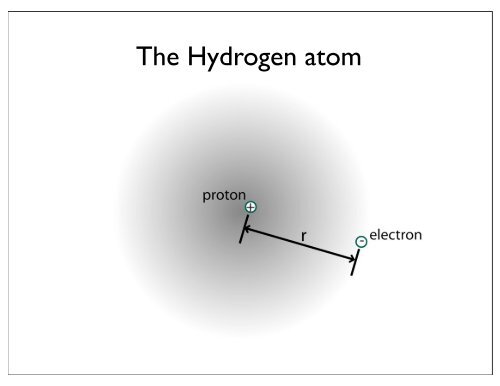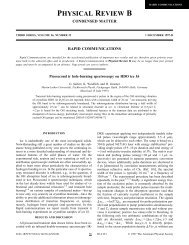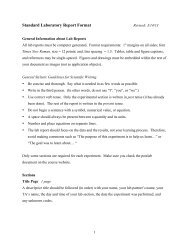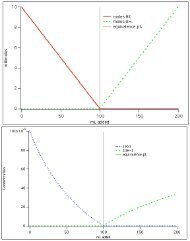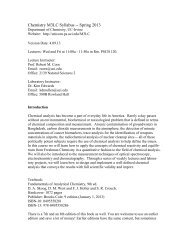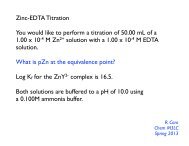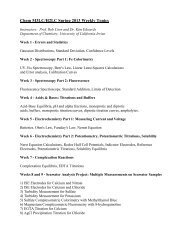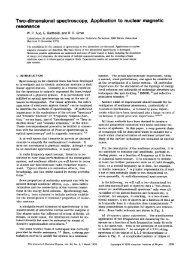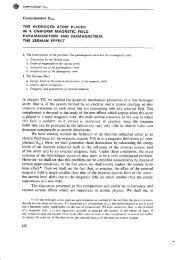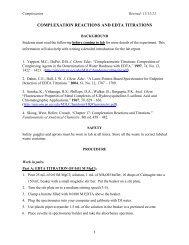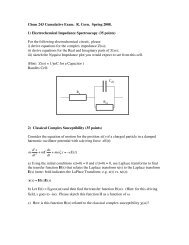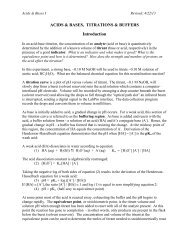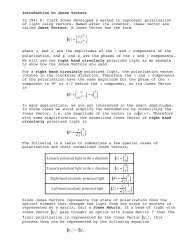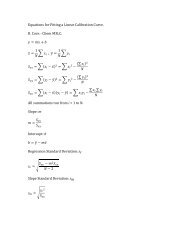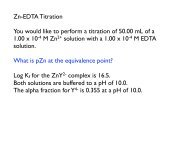The Hydrogen atom
The Hydrogen atom
The Hydrogen atom
Create successful ePaper yourself
Turn your PDF publications into a flip-book with our unique Google optimized e-Paper software.
<strong>The</strong> <strong>Hydrogen</strong> <strong>atom</strong>
Atomic Emission Spectroscopy<br />
the <strong>atom</strong>ic<br />
emission<br />
spectrum is<br />
the result of<br />
many <strong>atom</strong>s<br />
emitting light<br />
simultaneously.<br />
a spectrometer
Absorption and Emission Spectroscopy<br />
Light will be absorbed or<br />
emitted only if ∆E = hν<br />
<strong>The</strong> spectrum is QUANTIZED!<br />
∆E51=24G<br />
∆E41=15G<br />
∆E31=8G<br />
∆E21=3G<br />
G= h 2 /8mL 2
Atomic Emission Spectroscopy<br />
<strong>The</strong> emission spectra of H, He and Hg are all quantized!
Energy eigenvectors/eigenstates<br />
is the eigenstate vector solution<br />
to the Schrödinger equation.<br />
is the energy eigenvalue associated<br />
with this eigenstate vector.
<strong>Hydrogen</strong> eigenstates/wavefunctions<br />
State Vectors<br />
Three Dimensional Wavefunction<br />
(<strong>Hydrogen</strong> Atom)<br />
<strong>The</strong> spatial component of the eigenstate vector<br />
can be represented by a three dimensional<br />
wavefunction ψ(r) = ψ(x,y,z).
<strong>The</strong> <strong>Hydrogen</strong> Atom Hamiltonian<br />
V(r) is called the Coulomb potential.
WHEN we solve the Schrödinger equation, we<br />
always obtain two things:<br />
1. a set of eigenstate energies, En.<br />
Example: PIAB<br />
n = 1, 2, 3...
WHEN we solve the Schrödinger equation, we<br />
always obtain two things:<br />
1. a set of eigenstate energies, En.<br />
2. a set of eigenstate vectors |ψn>.<br />
Example: PIAB<br />
n = 1, 2, 3...<br />
Eigenstate vectors are labeled<br />
with the quantum number n.
WHEN we solve the Schrödinger equation, we<br />
always obtain two things:<br />
1. a set of eigenstate energies, En.<br />
<strong>Hydrogen</strong> <strong>atom</strong> solution:<br />
n = 1, 2, 3...
WHEN we solve the Schrödinger equation, we<br />
always obtain two things:<br />
1. a set of eigenstate energies, En.<br />
2. a set of eigenstate vectors |ψn>.<br />
<strong>Hydrogen</strong> <strong>atom</strong> solution:<br />
n = 1, 2, 3...<br />
State vectors are labeled with<br />
the quantum number n...<br />
AND three more: l, ml, ms
WHEN we solve the Schrödinger equation, we<br />
always obtain two things:<br />
1. a set of eigenstate energies, En.<br />
<strong>Hydrogen</strong> <strong>atom</strong> solution:<br />
n = 1, 2, 3...<br />
Let's focus on the energies first!
WHEN we solve the Schrödinger equation, we<br />
always obtain two things:<br />
1. a set of eigenstate energies, En.<br />
<strong>Hydrogen</strong> <strong>atom</strong> solution:<br />
n = 1, 2, 3... hcR = 13.60 eV<br />
R is the Rydberg constant.
WHEN we solve the Schrödinger equation, we<br />
always obtain two things:<br />
1. a set of eigenstate energies, En.<br />
A small aside about the Rydberg constant R:<br />
1.097 x 10 7 m -1 in SI units<br />
Atkins eliminates c from the definition of R, and ends<br />
up defining it in units of s -1 or Hz.<br />
R(Atkins) = Rc = (1.097 x 10 7 m -1 )x(2.997 x 10 8 m s -1 )<br />
= 3.288 x 10 15 Hz. Oh well.
WHEN we solve the Schrödinger equation, we<br />
always obtain two things:<br />
1. a set of eigenstate energies, En.<br />
<strong>Hydrogen</strong> <strong>atom</strong> solution:<br />
n = 1, 2, 3... hcR = 13.60 eV<br />
13.60 eV is the Ionization Potential for <strong>Hydrogen</strong>.
<strong>Hydrogen</strong> <strong>atom</strong> energy levels<br />
n=∞ 0 eV<br />
n=4<br />
-0.851 eV<br />
n=3 -1.51 eV<br />
n=2<br />
n=1<br />
-3.40 eV<br />
-13.60 eV<br />
E ≥0 means ionization<br />
hcR = 13.60 eV<br />
n = 1, 2, 3...<br />
n is called the<br />
principal quantum number.
H <strong>atom</strong> Emission Spectroscopy<br />
the <strong>atom</strong>ic<br />
emission<br />
spectrum is the<br />
result of many<br />
excited <strong>atom</strong>s<br />
emitting light<br />
simultaneously.<br />
a spectrometer
H <strong>atom</strong> Emission Spectrum<br />
From "Atomic Spectra and Atomic Structure" by G. Herzberg, 1937.
H <strong>atom</strong> Emission Spectrum<br />
<strong>The</strong>re are two more series in the UV and IR
Paschen<br />
series<br />
H <strong>atom</strong> Emission Spectrum<br />
<strong>The</strong>re are two more series in the UV and IR
Paschen<br />
series<br />
nfinal=3<br />
All of the lines within each of the 3 named<br />
spectroscopic “series” share the same nfinal.<br />
nfinal=2 nfinal=1
vacuum level<br />
All of the lines within each of the 3 named<br />
spectroscopic “series” share the same nfinal.<br />
-0.851 eV<br />
-1.51 eV<br />
-3.40 eV<br />
-13.60 eV
Actually, there are more series further in the IR.<br />
-0.851 eV<br />
-1.51 eV<br />
-3.40 eV<br />
-13.62 eV
...let’s do a few examples:<br />
ninitial<br />
2<br />
nfinal<br />
1
...let’s do a few examples:<br />
ninitial<br />
2<br />
nfinal<br />
1<br />
step 1 - look at<br />
series<br />
to get nfinal
...let’s do a few examples:<br />
step 2 - count up from last<br />
line to get<br />
ninitial starting at nfinal +1.<br />
ninitial<br />
2<br />
nfinal<br />
1
...another example...<br />
specify the initial and<br />
final states responsible<br />
for this emission line.
...another example...<br />
?<br />
nfinal<br />
= 2
...another example...<br />
ninitial<br />
= 6<br />
nfinal<br />
= 2
...another example...<br />
specify the initial and<br />
final states responsible<br />
for this emission line.
...another example...<br />
?<br />
nfinal<br />
= 3
...still another example...<br />
ninitial<br />
= 6<br />
nfinal<br />
3
...if we were asked, we could go one step further:<br />
we could calculate the energies of ninitial and nfinal and<br />
get the energy of the emitted photon.<br />
Let’s do one:<br />
Question: Calculate the wavelength of the photon<br />
emitted when a hydrogen <strong>atom</strong> in n=7 undergoes a<br />
transition to n=3.(what is the name of this series?).<br />
Key equation:<br />
hcR = 13.60 eV
Question: Calculate the wavelength of the photon<br />
emitted when a hydrogen <strong>atom</strong> in n=7 undergoes a<br />
transition to n=3 (what is the name of this series?).<br />
Key equation:<br />
hcR = 13.60 eV<br />
Step 1: Calculate En=7 and En=3.<br />
E7 = -13.60/7 2 = -0.2776 eV<br />
E3 = -13.60/3 2 = -1.511 eV
Question: Calculate the wavelength of the photon<br />
emitted when a hydrogen <strong>atom</strong> in n=7 undergoes a<br />
transition to n=3.<br />
Step 1: Calculate En=7 and En=3.<br />
E7 = -13.60/49 = -0.2776 eV<br />
E3 = -13.60/9 = -1.511 eV<br />
Step 2: Calculate ∆E...<br />
∆E = E7 - E3 = (-0.2776) - (-1.511) = 1.233 eV<br />
Step 3: Calculate ∆E...<br />
∆E = 1240./λ<br />
λ = 1240./ΔE = 1006 nm
<strong>The</strong>se energies work not only for hydrogen, but also to all<br />
hydrogen-like <strong>atom</strong>s (i.e., ANY <strong>atom</strong> with just one electron)<br />
with a nuclear charge of Z:<br />
example: He + (Z = 2),<br />
Li 2+ (Z = 3),<br />
Be 3+ (Z = 4),<br />
Cs 54+ (Z = 55).<br />
etc.<br />
<strong>Hydrogen</strong>-like <strong>atom</strong>s
WHEN we solve the Schrödinger equation, we<br />
always obtain two things:<br />
1. a set of eigenstates |ψn>.<br />
2. a set of eigenstate energies, En.<br />
<strong>Hydrogen</strong> <strong>atom</strong> solution:<br />
n = 1, 2, 3...<br />
hcR = 13.60 eV<br />
State vectors are labeled with<br />
the quantum number n...<br />
AND three more: l, ml, ms
<strong>Hydrogen</strong> <strong>atom</strong> quantum numbers<br />
n is called the principal quantum number.<br />
n = 1, 2, 3....<br />
l is called the orbital angular momentum quantum number.<br />
l = 0, 1, 2...(n-1) = s, p, d, f...<br />
ml is called the magnetic quantum number.<br />
ml = l, l-1,...-l<br />
ms is called the spin magnetic quantum number.<br />
ms= 1/2, -1/2 we'll deal with this one later.
<strong>Hydrogen</strong> <strong>atom</strong> wavefunctions<br />
<strong>The</strong> three dimensional H <strong>atom</strong> wavefunction can be defined<br />
by the three quantum numbers n, l, and ml.<br />
Three Dimensional Wavefunction<br />
(<strong>Hydrogen</strong> Atom)<br />
<strong>The</strong> spin magnetic quantum<br />
number doesn't appear in<br />
the wavefunction.
<strong>Hydrogen</strong> <strong>atom</strong> wavefunctions<br />
<strong>The</strong> three dimensional H <strong>atom</strong> wavefunction can be defined<br />
by the three quantum numbers n, l, and ml.<br />
ψ is a function of r, θ and Φ<br />
(spherical coordinates)
<strong>Hydrogen</strong> <strong>atom</strong> wavefunctions<br />
<strong>The</strong> three dimensional H <strong>atom</strong> wavefunction can be defined<br />
by the three quantum numbers n, l, and ml.<br />
Rn,l(r) is the radial component of the wavefunction.<br />
Rn,l depends on the two quantum<br />
numbers n and l.
<strong>Hydrogen</strong> <strong>atom</strong> wavefunctions<br />
<strong>The</strong> three dimensional H <strong>atom</strong> wavefunction can be defined<br />
by the three quantum numbers n, l, and ml.<br />
Yl,ml(θ,ϕ) is the angular component of the wavefunction.<br />
Yl,ml depends on the two quantum<br />
numbers l and ml.
<strong>Hydrogen</strong> <strong>atom</strong> wavefunctions
principal<br />
quanta n<br />
<strong>Hydrogen</strong> <strong>atom</strong> quantum numbers<br />
s p d f g h<br />
angular<br />
momentum<br />
quanta l<br />
A Grotrian diagram is what spectroscopists use<br />
to analyze their line spectra. Each column is for<br />
a different l quantum number. Note that only certain<br />
transitions are observed. <strong>The</strong>se are called selection rules.
Still to come:<br />
● ...Probability Densities for H <strong>atom</strong> orbitals.<br />
● ...Spin!<br />
● ...Aufbau principle for multielectron <strong>atom</strong>s.<br />
● ...electron configurations of multielectron <strong>atom</strong>s.<br />
● ...AES and Grotrian diagrams for different <strong>atom</strong>s.


